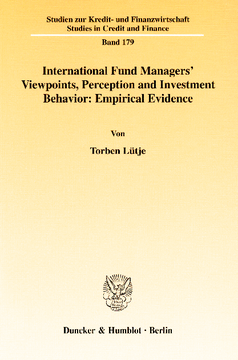International Fund Managers' Viewpoints, Perception and Investment Behavior: Empirical Evidence

BOOK
Cite BOOK
Style
Format
International Fund Managers' Viewpoints, Perception and Investment Behavior: Empirical Evidence
Studien zur Kredit- und Finanzwirtschaft / Studies in Credit and Finance, Vol. 179
(2005)
Additional Information
Book Details
Pricing
Abstract
Während institutionelle Investoren in stetig wachsenden Finanzmärkten seit Jahren unaufhaltsam an Bedeutung gewinnen, ist die Vorgehensweise dieser Marktakteure - insbesondere die der einflussreichen Untergruppe der Fondsmanager - bislang relativ unerforscht. Um diese Lücke zu schließen, beleuchtet Torben Lütje die Sichtweisen, die Wahrnehmung und das Anlageverhalten der Fondsmanager in den Vereinigten Staaten, in Deutschland sowie in der Schweiz mittels einer schriftlichen Befragung. Die Untersuchung bestätigt nicht nur vorherige empirische Ergebnisse, sondern liefert auch eine Vielzahl neuer Erkenntnisse über das Anlageverhalten von Fondsmanagern. Es zeigt sich, dass sie die Effizienz der Finanzmärkte dahingehend in Frage stellen, dass sie nicht nur verzerrtes Anlageverhalten am Markt wahrnehmen, sondern auch selbst Phänomenen wie beispielsweise einem Herdenverhalten und einer Heimatverzerrung in der Asset Allokation zumindest teilweise unterliegen.
Table of Contents
| Section Title | Page | Action | Price |
|---|---|---|---|
| Table of contents | 11 | ||
| 1. Introduction | 15 | ||
| 1.1 Motivation and contribution of this dissertation | 15 | ||
| 1.2 Outline | 17 | ||
| 1.3 Questionnaire | 19 | ||
| 2. Fund managers in Germany: What do they think and what do they do? | 25 | ||
| 2.1 Introduction | 25 | ||
| 2.2 Data | 27 | ||
| 2.3 What do fund managers think about their colleagues’ investment behavior? | 28 | ||
| 2.4 What do fund managers say about their own behavior? | 31 | ||
| 2.4.1 Incentives | 31 | ||
| 2.4.2 Information | 32 | ||
| 2.4.3 Decisions | 34 | ||
| 2.5 What characterizes fund managers from the academic point of view? | 36 | ||
| 2.5.1 Herding | 37 | ||
| 2.5.2 Non-fundamental information | 38 | ||
| 2.5.3 Investment strategies | 40 | ||
| 2.5.4 Home bias | 41 | ||
| 2.6 Conclusions | 43 | ||
| 3. To be good or to be better: Asset managers’ attitudes towards herding | 45 | ||
| 3.1 Introduction | 45 | ||
| 3.2 Survey methodology and design | 47 | ||
| 3.3 Survey findings on reputational herding | 48 | ||
| 3.4 Herding managers' working effort, preferred information and time horizon | 51 | ||
| 3.4.1 Herd behavior and working effort | 51 | ||
| 3.4.2 Herd behavior and use of information | 52 | ||
| 3.4.3 Herd behavior and investment horizon | 54 | ||
| 3.5 Herding managers' risk taking behavior | 55 | ||
| 3.5.1 Herd behavior and risk aversion | 55 | ||
| 3.5.2 Herd behavior and biased risk-taking behavior | 56 | ||
| 3.5.2.1 Loss aversion | 56 | ||
| 3.5.2.2 Disposition effect | 58 | ||
| 3.5.3 Herd behavior in the tournament | 59 | ||
| 3.6 Conclusions | 64 | ||
| 4. Stock price momentum: An already explained phenomenon? | 66 | ||
| 4.1 Introduction | 66 | ||
| 4.2 Preferred technical strategies – momentum versus contrarian | 67 | ||
| 4.3 Selection criteria for successful momentum strategies | 68 | ||
| 4.4 Explanatory approaches of stock price momentum | 69 | ||
| 4.4.1 Behavioral approaches | 69 | ||
| 4.4.2 Year end effects as momentum explanation | 72 | ||
| 4.4.3 Momentum explanations consistent with traditional theory | 73 | ||
| 4.4.4 Other explanations of momentum | 75 | ||
| 4.5 Conclusions | 76 | ||
| 5. Incentives and fund managers’ behavior: Trans-atlantic evidence | 78 | ||
| 5.1 Introduction | 78 | ||
| 5.2 Incentives in the fund management industry | 80 | ||
| 5.3 Data | 81 | ||
| 5.3.1 Questionnaire design and pretests | 81 | ||
| 5.3.2 Participation rate and responses | 82 | ||
| 5.4 Description of fund managers' bonus payments in three countries | 86 | ||
| 5.5 Institutional correlates of high bonus payments | 87 | ||
| 5.6 Bonus and working effort | 90 | ||
| 5.7 Bonus and risk-taking | 93 | ||
| 5.8 Bonus and opportunistic behavior | 97 | ||
| 5.9 Conclusions | 102 | ||
| 6. What drives home bias? Evidence from fund managers' views | 104 | ||
| 6.1 Introduction | 104 | ||
| 6.2 Data | 106 | ||
| 6.3 Survey findings on literature hypotheses | 107 | ||
| 6.3.1 The existence of home bias | 107 | ||
| 6.3.2 Suggested relations of home bias | 109 | ||
| 6.4 Survey findings on further relations | 112 | ||
| 6.4.1 Relations of home bias with institutional characteristics | 112 | ||
| 6.4.2 Relations of home bias with informational characteristics | 114 | ||
| 6.4.3 Relations of home bias with behavioral characteristics | 115 | ||
| 6.5 The relative importance of home bias' driving forces | 118 | ||
| 6.5.1 Statistical analyses of driving forces | 118 | ||
| 6.5.2 A qualitative discussion of driving forces | 119 | ||
| 6.6 Conclusions | 121 | ||
| Summary | 124 | ||
| Résumé | 126 | ||
| Zusammenfassung | 128 | ||
| References | 130 | ||
| Index | 139 |
